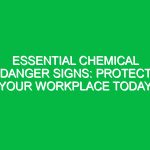In today’s fast-paced work Environment, the question of whether one can refuse to work alone is not just a matter of personal preference; it is a significant health and Safety concern. This article delves into the essential rights under Health, Safety, and Environment (HSE) regulations that empower employees to make informed decisions about their working conditions. Understanding these rights can help foster safer workplaces and ensure that workers are not put at undue risk.
Understanding the Concept of Refusing to Work Alone
The phrase can I refuse to work alone encapsulates a crucial right that employees have regarding their Safety and well-being on the job. Working alone can pose various risks, from health emergencies to accidents without immediate assistance. In many fields, particularly those involving hazardous materials or machinery, the dangers increase exponentially when workers are isolated.
When considering whether to refuse to work alone, it’s essential to recognize the applicable HSE Regulations in your jurisdiction. These regulations are designed to protect workers by establishing guidelines for safe work practices, including stipulations on working alone.
Key Aspects of Working Alone and HSE Rights
The right to refuse to work alone stems from broader HSE principles aimed at minimizing risks and ensuring worker safety. Here are several key aspects to consider:
- Risk Assessment: Employers are required to conduct thorough risk assessments to identify potential Hazards associated with working alone. This assessment should include factors such as the nature of the work, the environment, and the worker’s capability.
- Training and Information: Employees should receive adequate Training on the risks of working alone and the measures they can take to protect themselves. This includes understanding emergency protocols.
- Emergency Procedures: Employers must establish clear emergency procedures for situations where a worker is alone, ensuring that help can be reached quickly if needed.
- Communication Devices: Workers should have access to reliable communication devices to contact help if they find themselves in danger.
Legal Framework and Regulations
The legal framework surrounding the right to refuse to work alone varies by country and industry. However, several key regulations often come into play:
- Occupational Health and Safety (OHS) Acts: Many jurisdictions have OHS laws that require employers to provide a safe working environment. These laws often include provisions regarding working alone.
- Workplace Safety and Insurance Board (WSIB) Regulations: In regions with workers’ compensation boards, regulations may dictate conditions under which workers can refuse to work based on safety concerns.
- Industry-Specific Guidelines: Certain industries, such as construction and healthcare, may have specific guidelines that address the risks associated with working alone.
Understanding Your Rights
Employees have the right to refuse to work alone if they perceive that the conditions pose a significant risk to their safety. If faced with such a scenario, it is advisable to:
- Notify your supervisor or safety officer immediately.
- Document the reasons for your refusal, including any potential Hazards.
- Seek alternatives, such as working in pairs or teams.
Potential Hazards and Safety Considerations
Working alone can lead to several hazards, particularly in high-risk environments. Some of these hazards include:
- Medical Emergencies: In case of a medical issue, being alone can delay vital assistance.
- Accidents: If an accident occurs—such as a fall or equipment malfunction—there may be no one available to provide immediate help.
- Violence or Crime: In certain settings, such as retail or security, workers may face the risk of violence when alone.
Each of these hazards underscores the importance of having protocols in place to mitigate risks associated with working alone. Employers must take proactive measures to ensure that workers are not placed in unsafe situations.
Best Practices for Working Alone
To enhance safety in situations where working alone is unavoidable, consider the following Best Practices:
- Buddy System: Whenever possible, employ a buddy system where workers are paired together for tasks that are particularly risky.
- Regular Check-Ins: Establish a routine for check-ins, where workers report their status to a supervisor or colleague at regular intervals.
- Emergency Contact Plan: Ensure that all workers have access to emergency contact numbers and know how to use communication devices effectively.
- Safety Equipment: Equip workers with personal safety devices, such as alarms or GPS trackers, that can alert others in case of an emergency.
Real-Life Examples and Case Studies
To illustrate the importance of addressing the issue of working alone, consider the following hypothetical scenarios:
Scenario 1: The Warehouse Worker
In a busy warehouse, a worker is assigned to inventory tasks alone during late hours. Due to the lack of proper Safety Measures, they experience a minor injury and are unable to call for help. Thankfully, the worker had previously raised concerns about working alone, leading management to implement a check-in system. Because of this, they were able to receive help within minutes.
Scenario 2: The Remote Field Technician
A technician is sent to a remote location to service equipment. Regulations require that they work with a partner; however, due to scheduling conflicts, they are sent alone. During the job, the technician encounters a malfunction that could pose a risk of injury. Remembering their right to refuse unsafe work, they call their supervisor to express their concerns and refuse to proceed without assistance.
Both scenarios highlight the necessity of recognizing the right to refuse to work alone and the critical role of HSE regulations in safeguarding workers.
Taking Action: What to Do If You Feel Unsafe
If you find yourself in a situation where you feel unsafe working alone, here are actionable steps you can take:
- Assess the Situation: Understand the risks involved in your specific task.
- Communicate: Speak to your supervisor or management about your concerns.
- Document Everything: Keep a record of your communications and any incidents related to working alone.
- Know Your Rights: Familiarize yourself with the HSE regulations in your area regarding working alone.
Conclusion
In conclusion, the question of can I refuse to work alone is not just about personal preference—it is a fundamental right that ensures the safety and well-being of workers across various industries. By understanding the associated risks, recognizing your rights, and implementing Best Practices, you can contribute to a safer working environment. Always remember, prioritizing safety should never be a question; it should be a standard practice.


